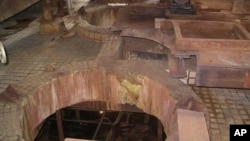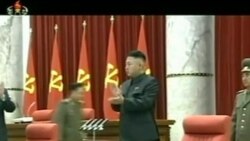SEOUL —
North Korea says it is restarting nuclear operations at the Yongbyon nuclear complex, adding to already heightened tensions on the Korean peninsula.
According to North Korean state media, a spokesman for the country's atomic energy department says it will begin, without delay, work to restart the uranium enrichment plant and the five megawatt graphite moderated reactor.
The action is being taken as part of the new “strategic line” announced by leader Kim Jong Un of “simultaneously pushing forward economic construction and the building of nuclear armed forces.”
Watch related video:
South Korea, China express regrets
In South Korea, foreign ministry spokesman Cho Tai-young called the North Korean announcement "truly regrettable," adding that North Korea should keep its promises and agreements and stick to denuclearization of the Korean peninsula.
China Tuesday also voiced its concern. "We have noticed the remarks of the DPRK and express our regrets," Beijing's foreign ministry spokesman Hong Lei said at a regular briefing. "We call on the relevant parties to keep calm and exercise restraint."
The North's Yongbyon facility was shuttered under an agreement reached in 2007 at six-party talks including the United States, China, Russia, Japan and South Korea. North Korea destroyed the plant's cooling tower the next year and would presumably need to rebuild it before the reactor could be restarted.
Refurbishing the facility would allow North Korea to make nuclear weapons by extracting plutonium from highly radioactive fuel rods that are no longer usable for making electricity.
Scientists estimate the reactor would need to run for about one year before North Korea could extract enough plutonium for one additional nuclear weapon.
South Korea, US militaries making preparations for deterrence
Before the announcement from Pyongyang Tuesday, South Korean President Park Geun-hye held an unscheduled security meeting with her defense and unification ministers and national intelligence chief.
Presidential spokesman Yoon Chang-jung says the president has decreed that it will be necessary to strongly punish North Korea, should it provoke. But, Yoon says it is more important to have strong diplomatic and military deterrence to ensure that North Korea does nothing provocative.
The statement was made just minutes before the announcement from Pyongyang about the Yongbyon nuclear facility.
South Korea says it is keeping a close eye on North Korea's Tongchang-ri launch site. Defense Ministry spokesman Kim Min-seok told reporters Tuesday there appeared to be no signs of an imminent missile launch. But, what activities South Korea has detected at the site are secret and cannot be revealed.
Meanwhile, the United States is deploying anti-missile ships to back up its public statements that it takes the continuing military threats from North Korea very seriously. Military sources say the U.S. Navy's Seventh fleet has moved the USS McCain to a position off the southwestern coast of South Korea.
Another destroyer, the USS Decatur, is reported to be on the way to the Korean peninsula, along with a sea-based X-band radar platform that can track possible missile launches.
A Defense Department official called this "a prudent move that provides greater missile defense options, should they become necessary."
The positioning of the navy vessels follows the publicized simulated bombing runs of U.S. Air Force B-52 and B-2 bombers as part of the annual Foal Eagle joint exercise with South Korea's military.
On Sunday, a pair of F-22 Raptors, the Air Force's premier stealth fighter jets, flew from Okinawa, Japan. The Pentagon says they are on now on “static display” at Osan Air Base in South Korea as part of “alliance assurance.”
Military sources in Washington and Seoul say they have detected no mobilization of North Korea's forces, despite the near-daily rhetoric from Pyongyang that its forces are poised for an open conflict.
In a rare “special statement” the North declared relations with the South in a “state of war,” March 30.
South Korean Foreign Minister Yun Byung-se is scheduled to hold his first talks with U.S. Secretary of State John Kerry in Washington, Tuesday. Secretary Kerry is scheduled to travel to South Korea, later this month.
Additional reporting by Shannon Van Sant in Beijing
According to North Korean state media, a spokesman for the country's atomic energy department says it will begin, without delay, work to restart the uranium enrichment plant and the five megawatt graphite moderated reactor.
The action is being taken as part of the new “strategic line” announced by leader Kim Jong Un of “simultaneously pushing forward economic construction and the building of nuclear armed forces.”
Watch related video:
South Korea, China express regrets
In South Korea, foreign ministry spokesman Cho Tai-young called the North Korean announcement "truly regrettable," adding that North Korea should keep its promises and agreements and stick to denuclearization of the Korean peninsula.
China Tuesday also voiced its concern. "We have noticed the remarks of the DPRK and express our regrets," Beijing's foreign ministry spokesman Hong Lei said at a regular briefing. "We call on the relevant parties to keep calm and exercise restraint."
The North's Yongbyon facility was shuttered under an agreement reached in 2007 at six-party talks including the United States, China, Russia, Japan and South Korea. North Korea destroyed the plant's cooling tower the next year and would presumably need to rebuild it before the reactor could be restarted.
Refurbishing the facility would allow North Korea to make nuclear weapons by extracting plutonium from highly radioactive fuel rods that are no longer usable for making electricity.
Scientists estimate the reactor would need to run for about one year before North Korea could extract enough plutonium for one additional nuclear weapon.
Tensions Rising on Korean Peninsula
Tensions Rising on Korean Peninsula- February 12: North Korea carries out third nuclear test
- March 27: North Korea cuts military hotline with South Korea
- March 28: U.S. B-2 bombers fly over Korean peninsula
- March 30: North Korea says it has entered a "state of war" with South Korea
- April 3: North Korea blocks South Korean workers from Kaesong
- April 4: North Korea moves a missile to its east coast
- April 9: North Korea urges foreigners to leave the South. The U.S. and South Korea raise alert level
- April 14: US Secretary of State John Kerry offers talks with Pyongyang if it moves to scrap nuclear weapons
- April 16: North Korea issues threats after anti-Pyongyang protests in Seoul
- April 29: North Korea holds back seven South Koreans at Kaesong
- April 30: North Korea sentences American to 15 years hard labor for hostile acts
- May 20: North Korea fires projectiles for a consecutive third day
- May 24: North Korean envoy wraps up China visit for talks on Korean tensions
- June 7: South Korea accepts Pyongyang's offer of talks on Kaesong and other issues
Before the announcement from Pyongyang Tuesday, South Korean President Park Geun-hye held an unscheduled security meeting with her defense and unification ministers and national intelligence chief.
Presidential spokesman Yoon Chang-jung says the president has decreed that it will be necessary to strongly punish North Korea, should it provoke. But, Yoon says it is more important to have strong diplomatic and military deterrence to ensure that North Korea does nothing provocative.
The statement was made just minutes before the announcement from Pyongyang about the Yongbyon nuclear facility.
South Korea says it is keeping a close eye on North Korea's Tongchang-ri launch site. Defense Ministry spokesman Kim Min-seok told reporters Tuesday there appeared to be no signs of an imminent missile launch. But, what activities South Korea has detected at the site are secret and cannot be revealed.
Meanwhile, the United States is deploying anti-missile ships to back up its public statements that it takes the continuing military threats from North Korea very seriously. Military sources say the U.S. Navy's Seventh fleet has moved the USS McCain to a position off the southwestern coast of South Korea.
Another destroyer, the USS Decatur, is reported to be on the way to the Korean peninsula, along with a sea-based X-band radar platform that can track possible missile launches.
A Defense Department official called this "a prudent move that provides greater missile defense options, should they become necessary."
The positioning of the navy vessels follows the publicized simulated bombing runs of U.S. Air Force B-52 and B-2 bombers as part of the annual Foal Eagle joint exercise with South Korea's military.
On Sunday, a pair of F-22 Raptors, the Air Force's premier stealth fighter jets, flew from Okinawa, Japan. The Pentagon says they are on now on “static display” at Osan Air Base in South Korea as part of “alliance assurance.”
Military sources in Washington and Seoul say they have detected no mobilization of North Korea's forces, despite the near-daily rhetoric from Pyongyang that its forces are poised for an open conflict.
In a rare “special statement” the North declared relations with the South in a “state of war,” March 30.
South Korean Foreign Minister Yun Byung-se is scheduled to hold his first talks with U.S. Secretary of State John Kerry in Washington, Tuesday. Secretary Kerry is scheduled to travel to South Korea, later this month.
Additional reporting by Shannon Van Sant in Beijing












